The Impact of Natural Factors on Net Primary Productivity in Heilongjiang Province Under Different Land Use and Land Cover Changes
Abstract
1. Introduction
2. Materials and Methods
2.1. Study Area
2.2. Data
2.2.1. LUCC and NPP
2.2.2. Impact Factor Dataset
2.3. Methods
2.3.1. Identification of Study Land Use Types
2.3.2. Spatiotemporal Trends in NPP Changes
2.3.3. Detection of Impact Factors on NPP
2.4. Research Workflow Chart
3. Results
3.1. Determination of Study Land Types
3.2. Spatiotemporal Distribution of NPP and Differences Across Land Types
3.2.1. Geospatial Dynamics in Multiyear NPP Averages and Land-Type Heterogeneity
3.2.2. Geospatial Variability in NPP Transition Dynamics and Inter-Category Disparities
3.3. Analysis of Factors Influencing NPP Across Land Categories
3.3.1. Assessment of the Separate Influence of Natural Factors on NPP
3.3.2. Analysis of the Interactive Effects of Natural Factors on NPP
4. Discussion
4.1. Land Use Change Analysis
4.2. Analysis of NPP Change Trends
4.3. Response of NPP Changes to Natural Factors
4.4. Limitations and Future Prospects
5. Conclusions
- (1)
- NPP showed clear spatial heterogeneity across land use types. Forest areas—the dominant ecosystem—exhibited the highest mean annual NPP (514.05 g C·m−2·a−1), followed by croplands (359.01 g C·m−2·a−1), while shrub–grass–other areas had the lowest (269.18 g C·m−2·a−1). Among changing land types, forest- and cropland-derived categories showed relatively high NPP, whereas secondary cropland remained the lowest.
- (2)
- Over the study period, vegetation NPP across study area displayed a significant increasing trend. This was especially evident in areas where land use remained stable, underscoring the positive effect of land use consistency on ecosystem carbon sequestration.
- (3)
- Among natural factors, mean annual temperature, precipitation, soil water content, evapotranspiration, and elevation all have significant impacts on variations in vegetation NPP. Specifically, the interaction between mean annual precipitation and mean annual temperature exhibits strong explanatory power across multiple land use types, indicating that the synergistic effect of hydrothermal conditions is a key factor driving changes in vegetation productivity. Additionally, elevation often interacts with other factors to jointly influence NPP, highlighting the importance of topography in regulating the functions of regional ecosystems.
Author Contributions
Funding
Data Availability Statement
Conflicts of Interest
Appendix A
| Value | Name | Description |
|---|---|---|
| 1 | Evergreen Needleleaf Forests | Dominated by evergreen conifer trees (canopy > 2 m). Tree cover >60%. |
| 2 | Evergreen Broadleaf Forests | Dominated by evergreen broadleaf and palmate trees (canopy > 2 m). Tree cover >60%. |
| 3 | Deciduous Needleleaf Forests | Dominated by deciduous needleleaf (larch) trees (canopy > 2 m). Tree cover >60%. |
| 4 | Deciduous Broadleaf Forests | Dominated by deciduous broadleaf trees (canopy > 2 m). Tree cover >60%. |
| 5 | Mixed Forests | Dominated by neither deciduous nor evergreen (40–60% of each) tree type (canopy > 2 m). Tree cover >60%. |
| 6 | Closed Shrublands | Dominated by woody perennials (1–2 m height) > 60% cover. |
| 7 | Open Shrublands | Dominated by woody perennials (1–2 m height) 10–60% cover. |
| 8 | Woody Savannas | Tree cover 30–60% (canopy > 2 m). |
| 9 | Savannas | Tree cover 10–30% (canopy > 2 m). |
| 10 | Grasslands | Dominated by herbaceous annuals (<2 m). |
| 11 | Permanent Wetlands | Permanently inundated lands with 30–60% water cover and >10% vegetated cover. |
| 12 | Croplands | At least 60% of area is cultivated cropland. |
| 13 | Urban and Built-up Lands | At least 30% impervious surface area including building materials, asphalt, and vehicles. |
| 14 | Cropland/Natural Vegetation Mosaics | Mosaics of small-scale cultivation 40–60% with natural tree, shrub, or herbaceous vegetation. |
| 15 | Permanent Snow and Ice | At least 60% of area is covered by snow and ice for at least 10 months of the year. |
| 16 | Barren | At least 60% of area is non-vegetated barren (sand, rock, soil) areas with less than 10% vegetation. |
| 17 | Water Bodies | At least 60% of area is covered by permanent water bodies. |
| Category | Coding inMCD12Q1 | Recoded Classification in Study |
|---|---|---|
| Cropland | 12, 14 | 1 |
| Forest | 1, 2, 3, 4, 5, 8, 9 | 2 |
| SGO | 6, 7, 10, 11 | 3 |
| Urban | 13 | 4 |
| Bare area | 16 | 5 |
| WIS | 15, 17 | 6 |
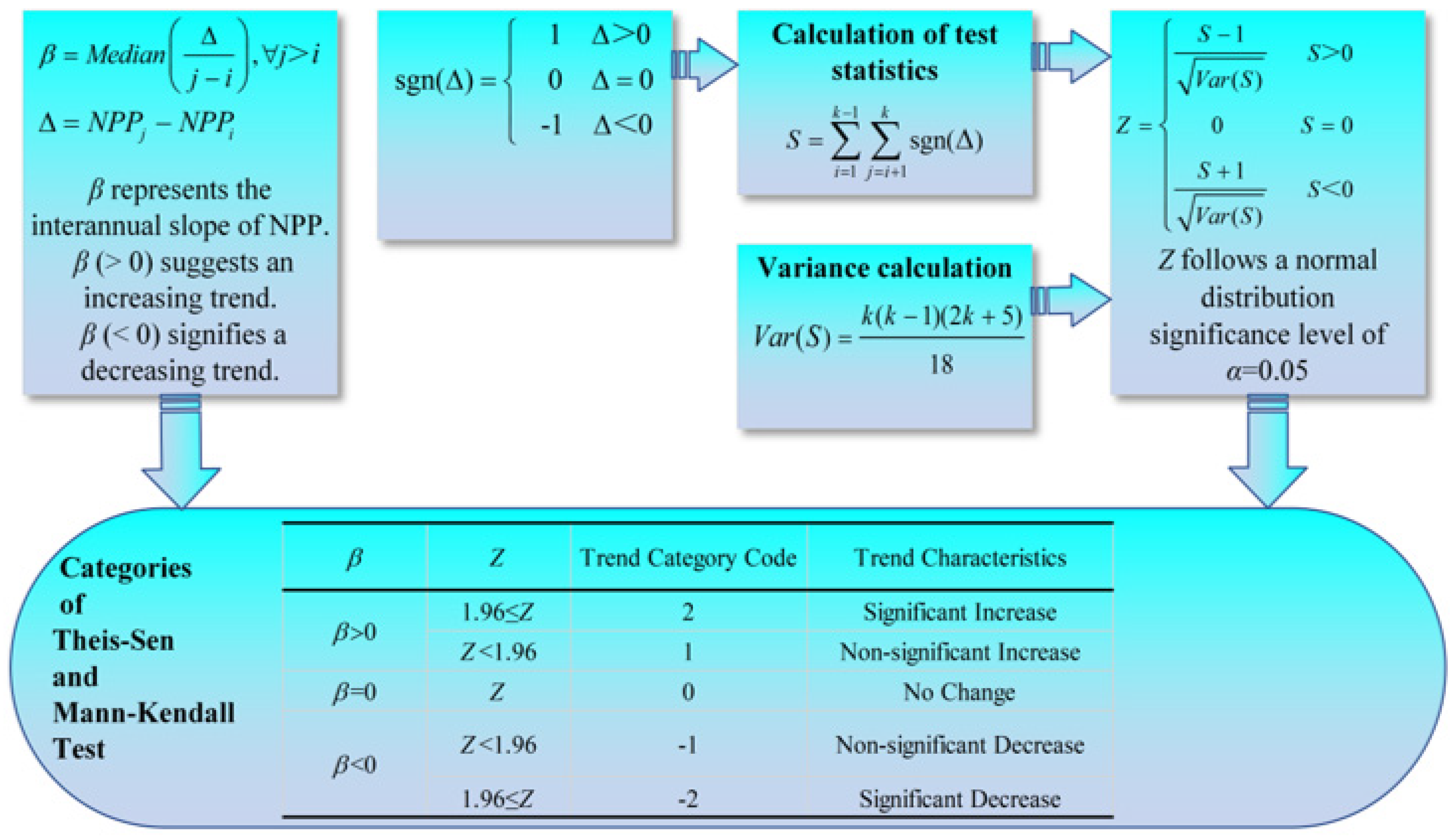
References
- Cao, M.; Woodward, F.I. Dynamic responses of terrestrial ecosystem carbon cycling to global climate change. Nature 1998, 393, 249–252. [Google Scholar] [CrossRef]
- Liu, J.; Chen, J.M.; Cihlar, J.; Chen, W.; Liu, J.; Chen, J.M.; Cihlar, J.; Chen, W. Net primary productivity distribution in the BOREAS region from a process model using satellite and surface data. J. Geophys. Res. 1999, 104, 27735–27754. [Google Scholar]
- Field, C.B.; Behrenfeld, M.J.; Randerson, J.T.; Falkowski, P. Primary Production of the Biosphere: Integrating Terrestrial and Oceanic Components. Science 1998, 281, 237–240. [Google Scholar] [CrossRef]
- Zhu, W.Q.; Pan, Y.Z.; Long, Z.H.; Chen, Y.H.; Li, J.; H, H.B. Estimating Net Primary Productivity of Terrestrial Vegetation Based on GIS and RS:A Case Study in Inner Mongolia, China. Natl. Remote Sens. Bull. 2005, 3, 300–307. [Google Scholar]
- Bejagam, V.; Sharma, A. Impact of climatic changes and anthropogenic activities on ecosystem net primary productivity in India during 2001–2019. Ecol. Inform. 2022, 70, 101732. [Google Scholar] [CrossRef]
- Lehnert, L.W.; Wesche, K.; Trachte, K.; Reudenbach, C.; Bendix, J. Climate variability rather than overstocking causes recent large scale cover changes of Tibetan pastures. Sci. Rep. 2016, 6, 24367. [Google Scholar] [CrossRef] [PubMed]
- Byrne, K.M.; Adler, P.B.; Lauenroth, W.K. Contrasting effects of precipitation manipulations in two Great Plains plant communities. J. Veg. Sci. 2017, 28, 238–249. [Google Scholar] [CrossRef]
- Jiang, H.; Xu, X.; Guan, M.; Wang, L.; Huang, Y.; Jiang, Y. Determining the contributions of climate change and human activities to vegetation dynamics in agro-pastural transitional zone of northern China from 2000 to 2015. Sci. Total Environ. 2020, 718, 134871. [Google Scholar] [CrossRef]
- Yuan, M.; Zhu, Q.; Zhang, J.; Liu, J.; Chen, H.; Peng, C.; Li, P.; Li, M.; Wang, M.; Zhao, P. Global response of terrestrial gross primary productivity to climate extremes. Sci. Total Environ. 2021, 750, 142337. [Google Scholar] [CrossRef]
- Kumar, D.; Pfeiffer, M.; Gaillard, C.; Langan, L.; Scheiter, S. Climate change and elevated CO2 favor forest over savanna under different future scenarios in South Asia. Biogeosciences 2021, 18, 2957–2979. [Google Scholar] [CrossRef]
- Liu, Y.; Li, Z.; Chen, Y. Continuous warming shift greening towards browning in the Southeast and Northwest High Mountain Asia. Sci. Rep. 2021, 11, 17920. [Google Scholar] [CrossRef] [PubMed]
- Zhang, Y.; Peña-Arancibia, J.L.; McVicar, T.R.; Chiew, F.H.S.; Vaze, J.; Liu, C.; Lu, X.; Zheng, H.; Wang, Y.; Liu, Y.Y.; et al. Multi-decadal trends in global terrestrial evapotranspiration and its components. Sci. Rep. 2016, 6, 19124. [Google Scholar] [CrossRef] [PubMed]
- Stocker, B.D.; Zscheischler, J.; Keenan, T.F.; Prentice, I.C.; Peñuelas, J.; Seneviratne, S.I. Quantifying soil moisture impacts on light use efficiency across biomes. New Phytol. 2018, 218, 1430–1449. [Google Scholar] [CrossRef] [PubMed]
- Körner, C. The use of ‘altitude’ in ecological research. Trends Ecol. Evol. 2007, 22, 569–574. [Google Scholar] [CrossRef]
- Yi, M.; Zhang, D.; An, Z.; Li, K.; Shang, L.; Sui, K. Analysis of Spatiotemporal Variation and Driving Forces of Vegetation Net Primary Productivity in the North China Plain over the Past Two Decades. Agronomy 2025, 15, 975. [Google Scholar] [CrossRef]
- Liang, W.; Yang, Y.T.; Fan, D.M.; Guan, H.D.; Zhang, T.; Long, D.; Zhou, Y.; Bai, D. Analysis of spatial and temporal patterns of net primary production and their climate controls in China from 1982 to 2010. Agric. For. Meteorol. 2015, 204, 22–36. [Google Scholar] [CrossRef]
- Yan, J.X.; Huang, H.; Gao, Y.H.; Zhang, Y. Estimation and Spatial-Temporal Dynamics of Long-term Sequenced Vegetation Net Primary Productivity in Jilin Province. J. Soil Water Conserv. 2021, 35, 172–180. [Google Scholar]
- Shao, J.H.; Li, J.; Yan, X.G.; Ma, T.; Zhang, Z. Analysis of Spatiotemporal Variation Characteristics and Driving Forces of NPP in Shanxi Province from 2000 to 2020 Based on Geodetector. Environ. Sci. 2023, 44, 312–322. [Google Scholar]
- Zhou, Y.Y.; Yue, D.X.; Li, C.; Mu, X.L.; Guo, J.J. Identifying the spatial drivers of net primary productivity: A case study in the Bailong River Basin, China. Glob. Ecol. Conserv. 2021, 28, e01685. [Google Scholar] [CrossRef]
- Guo, Y.; Yang, Y.; Yang, D.; Zhang, L.; Zheng, H.; Xiong, J.; Ruan, F.; Han, J.; Liu, Z. Warming leads to both earlier and later snowmelt floods over the past 70 years. Nat. Commun. 2025, 16, 3663. [Google Scholar] [CrossRef]
- Cui, N.B.; Wang, S.N. Dynamic change and trend analysis of cultivated land pressure in typical black soil areas of Northeast China under food security. Trans. Chin. Soc. Agric. Eng. 2022, 38, 220–230. [Google Scholar]
- Wang, Z.Q.; Liu, B.Y.; Wang, X.Y.; Gao, X.F.; Liu, G. Erosion effect on the productivity of black soil in Northeast China. Sci. China Ser. D Earth Sci. 2009, 52, 1005–1021. [Google Scholar] [CrossRef]
- Sun, B.F.; Zhao, H.; Lu, F.; Wang, X.K. Spatial and temporal patterns of carbon sequestration in the Northeastern Forest Regions and its impact factors analysis. Acta Ecol. Sin. 2018, 38, 4975–4983. [Google Scholar] [CrossRef]
- Friedl, M.; Sulla-Menashe, D. MCD12Q1 MODIS/Terra+Aqua Land Cover Type Yearly L3 Global 500m SIN Grid V006 2019; NASA Land Processes Distributed Active Archive Center: Sioux Falls, SD, USA, 2019.
- Jing, Q.Q.; He, J.J.; Li, Y.R.; Yang, X.Y.; Peng, Y.; Wang, H.; Yu, F.; Wu, J.; Gong, S.; Che, H.; et al. Analysis of the spatiotemporal changes in global land cover from 2001 to 2020. Sci. Total Environ. 2024, 908, 168354. [Google Scholar] [CrossRef]
- Wang, D.C.; Gong, J.H.; Chen, L.D.; Zhang, L.H.; Song, Y.Q.; Yue, Y.J. Spatio-temporal pattern analysis of land use/cover change trajectories in Xihe watershed. Int. J. Appl. Earth Obs. Geoinf. 2012, 14, 12–21. [Google Scholar] [CrossRef]
- Cai, B.F.; Yu, R. Advance and evaluation in the long time series vegetation trends research based on remote sensing. Natl. Remote Sens. Bull. 2009, 13, 1170–1186. [Google Scholar]
- Wang, J.F.; Xu, C.D. Geodetector: Principle and prospective. Acta Geogr. Sin. 2017, 72, 116–134. [Google Scholar]
- Song, Y.Z.; Wang, J.; Ge, Y.; Xu, C.D. An optimal parameters-based geographical detector model enhances geographic characteristics of explanatory variables for spatial heterogeneity analysis: Cases with different types of spatial data. GIScience Remote Sens. 2020, 57, 593–610. [Google Scholar] [CrossRef]
- Duan, Y.Y.; Pei, X.; Luo, J.; Zhang, X.C.; Luo, L.G. Disentangling the Spatiotemporal Dynamics, Drivers, and Recovery of NPP in Co-Seismic Landslides: A Case Study of the 2017 Jiuzhaigou Earthquake, China. Forests 2024, 15, 1381. [Google Scholar] [CrossRef]
- Muller, K. Statistical Power Analysis for the Behavioral Sciences. Technometrics 1989, 31, 499–500. [Google Scholar] [CrossRef]
- Verburg, P.H.; Soepboer, W.; Veldkamp, A.; Limpiada, R.; Espaldon, V.; Mastura, S.S.A. Modeling the spatial dynamics of regional land use: The CLUE-S model. Environ. Manag. 2002, 30, 391–405. [Google Scholar] [CrossRef]
- Castella, J.-C.; Verburg, P.H. Combination of process-oriented and pattern-oriented models of land-use change in a mountain area of Vietnam. Ecol. Model. 2007, 202, 410–420. [Google Scholar] [CrossRef]
- Wang, J.K.; Xu, X.R.; Pei, J.B.; Li, S.Y. Current Situations of Black Soil Quality and Facing Opportunities andChallenges in Northeast China. Chin. J. Soil Sci. 2021, 52, 695–701. [Google Scholar]
- Xu, Z.Y. Study on development potential and layout of farmland irrigation in Heilongjiang Province. Heilongjiang Hydraul. Sci. Technol. 2025, 53, 65–68. [Google Scholar]
- Luo, P.P.; Liu, Y.K.; Chen, Y.; Liu, Y.L.; Tian, S.Y.; Qi, F.K. Spatiotemporal patterns and influencing factors of vegetation NPP in Heilongjiang Province. Environ. Ecol. 2024, 6, 19–29+36. [Google Scholar]
- Chen, C.X.; Yu, M.; Wu, M.X.; Yu, B.; Mao, Z.J. Analysis of driving factors of terrestrial vegetation NPP in Heilongjiang Province from 2000 to 2020. J. Northeast Agric. Univ. 2022, 53, 20–28+75. [Google Scholar]
- Chen, C.X.; Yu, M.; Mao, Z.J.; Xie, L.N.; Zhang, Y.C.; Sun, T.; Xu, Z.; Wu, S.; Li, Q.; Xu, J. Spatial-Temporal Evolution and Patterns of Abrupt Changs of NPP in Heilongjiang Province in the Process of Ecological Protection and Restoration in China. Sci. Silvae Sin. 2022, 58, 23–31. [Google Scholar]
- Lu, F.; Hu, H.F.; Sun, W.J.; Zhu, J.J.; Liu, G.B.; Zhou, W.; Zhang, Q.; Shi, P.; Liu, X.; Wu, X.; et al. Effects of national ecological restoration projects on carbon sequestration in China from 2001 to 2010. Proc. Natl. Acad. Sci. USA 2018, 115, 4039–4044. [Google Scholar] [CrossRef]
- Deng, L.; Liu, G.; Shangguan, Z. Land use conversion and changing soil carbon stocks in China’s ‘Grain-for-Green’ Program: A synthesis. Glob. Change Biol. 2014, 20, 3544–3556. [Google Scholar] [CrossRef]
- Wang, J.F.; Huang, Q.Y.; Xi, L.H.; Cao, H.J.; Wang, J.B.; Dong, H.; Zeng, S.; Ni, H. Relationship between Plant Community Species Diversity and Vegetation Carbon Storage in Songnen Grassland. Chin. J. Grassl. 2022, 44, 33–42. [Google Scholar]
- He, C.; Tian, J.; Gao, B.; Zhao, Y. Differentiating climate- and human-induced drivers of grassland degradation in the Liao River Basin, China. Environ. Monit. Assess. 2015, 187, 4199. [Google Scholar] [CrossRef] [PubMed]
- Hou, L.L.; Xia, F.; Chen, Q.H.; Huang, J.; He, Y.; Rose, N.; Rozelle, S. Grassland ecological compensation policy in China improves grassland quality and increases herders’ income. Nat. Commun. 2021, 12, 4683. [Google Scholar] [CrossRef] [PubMed]
- Piao, S.; Wang, X.; Park, T.; Chen, C.; Lian, X.; He, Y.; Bjerke, J.W.; Chen, A.; Ciais, P.; Tømmervik, H.; et al. Characteristics, drivers and feedbacks of global greening. Nat. Rev. Earth Environ. 2019, 1, 14–27. [Google Scholar] [CrossRef]
- Bonan, G.B. Forests and Climate Change: Forcings, Feedbacks, and the Climate Benefits of Forests. Science 2008, 320, 1444–1449. [Google Scholar] [CrossRef] [PubMed]
- Wang, Z.; Liang, C.; Liu, J.; Liu, H.; Xu, X.; Xue, P.; Gong, H.; Jiao, F.; Zhang, M. How urbanization shapes the ecosystem carbon sink of vegetation in China: A spatiotemporal analysis of direct and indirect effects. Urban Clim. 2024, 55, 101896. [Google Scholar] [CrossRef]
- Bennie, J.; Huntley, B.; Wiltshire, A.; Hill, M.O.; Baxter, R. Slope, aspect and climate: Spatially explicit and implicit models of topographic microclimate in chalk grassland. Ecol. Model. 2008, 216, 47–59. [Google Scholar] [CrossRef]
- Wiesmeier, M.; Urbanski, L.; Hobley, E.; Lang, B.; von Lützow, M.; Marin-Spiotta, E.; van Wesemael, B.; Rabot, E.; Ließ, M.; Garcia-Franco, N.; et al. Soil organic carbon storage as a key function of soils—A review of drivers and indicators at various scales. Geoderma 2019, 333, 149–162. [Google Scholar] [CrossRef]
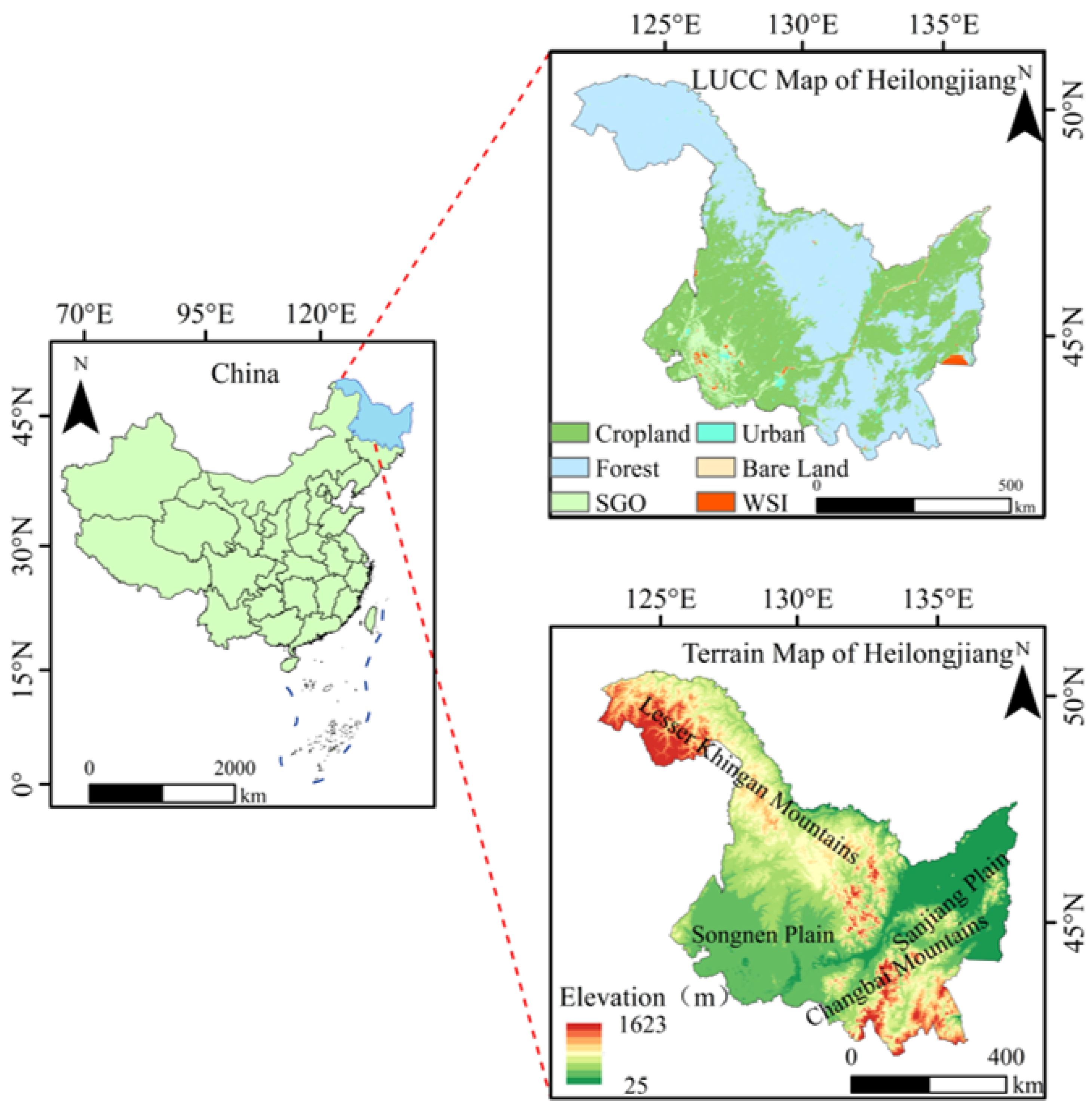
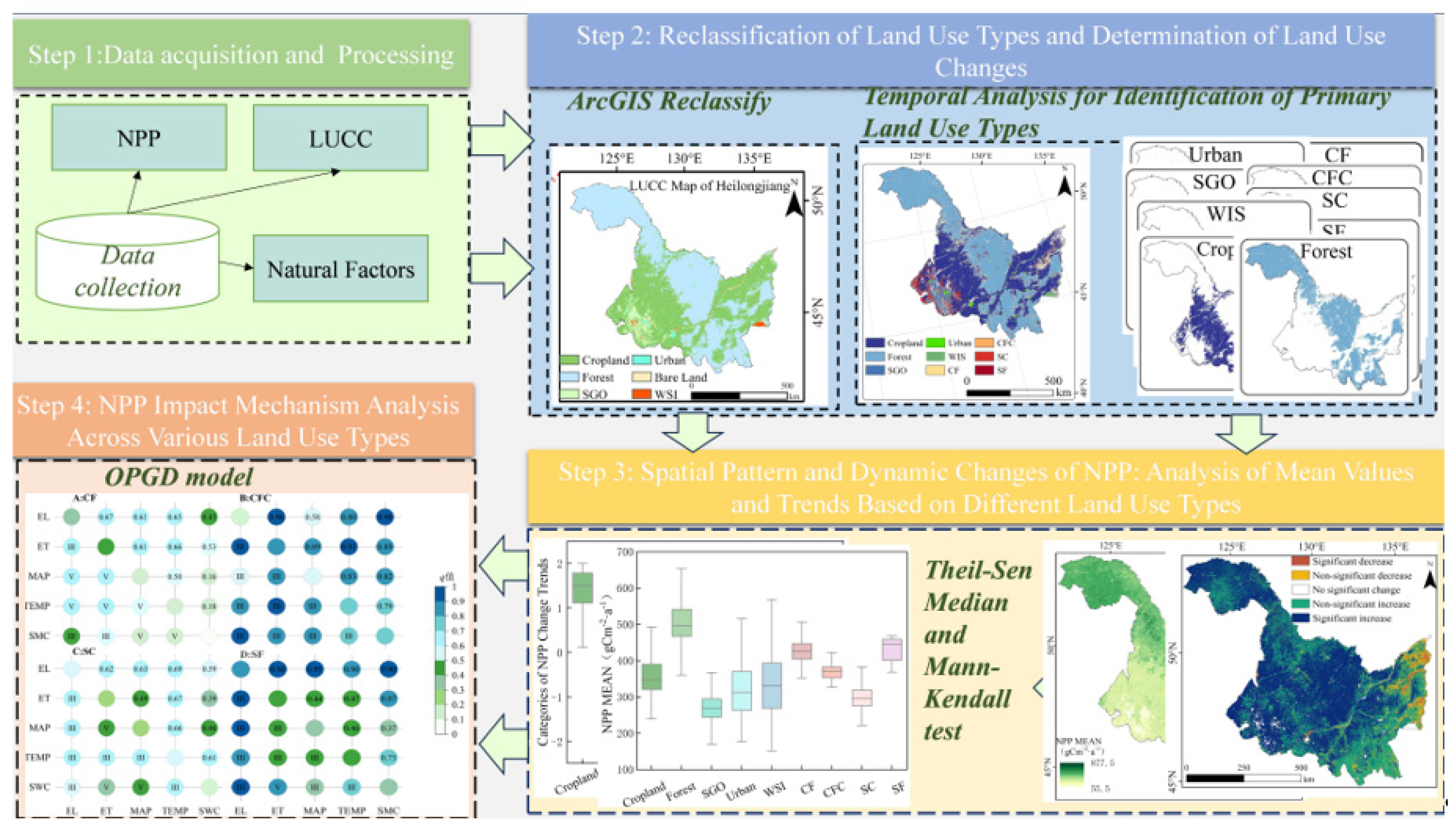
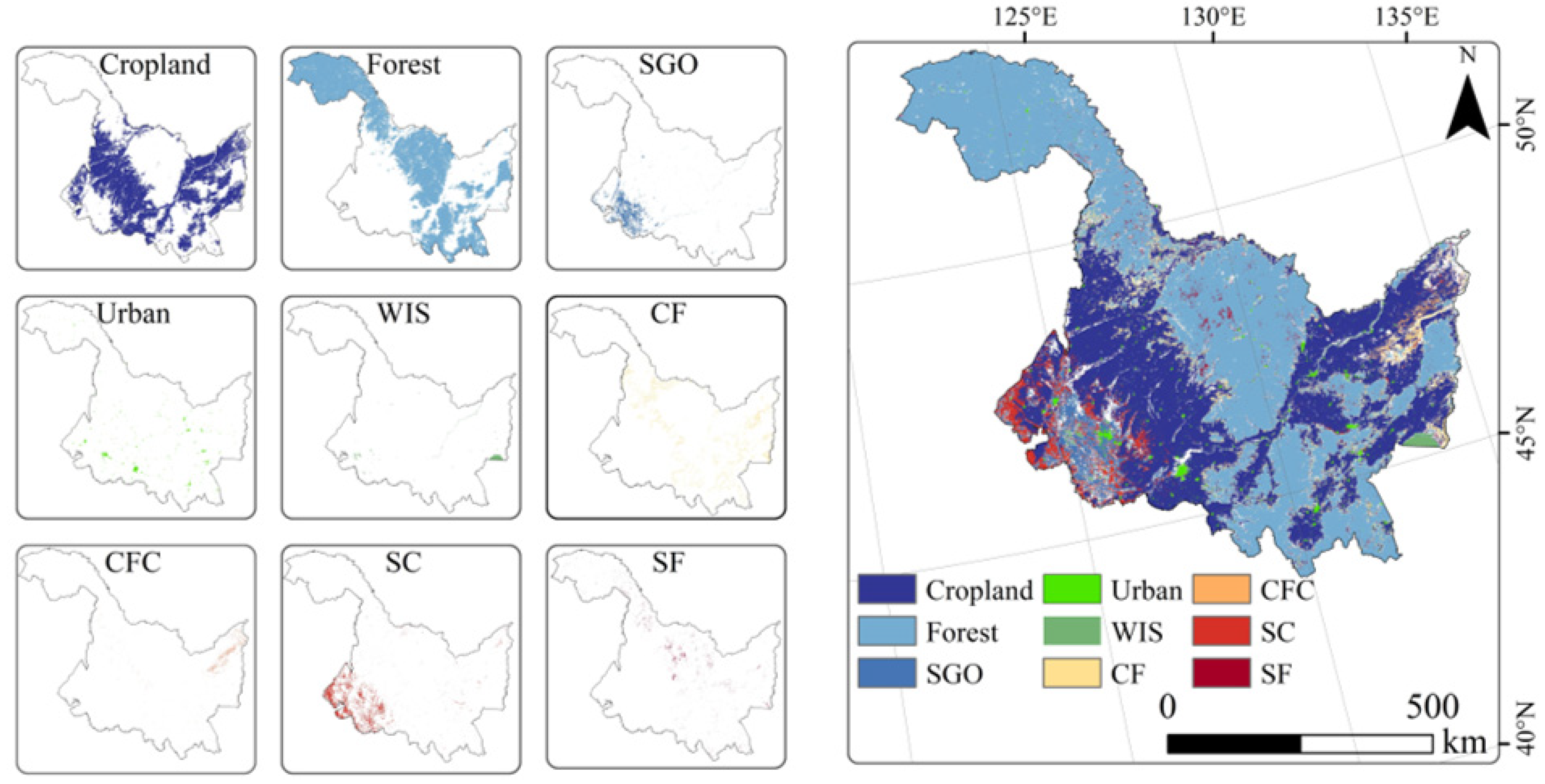
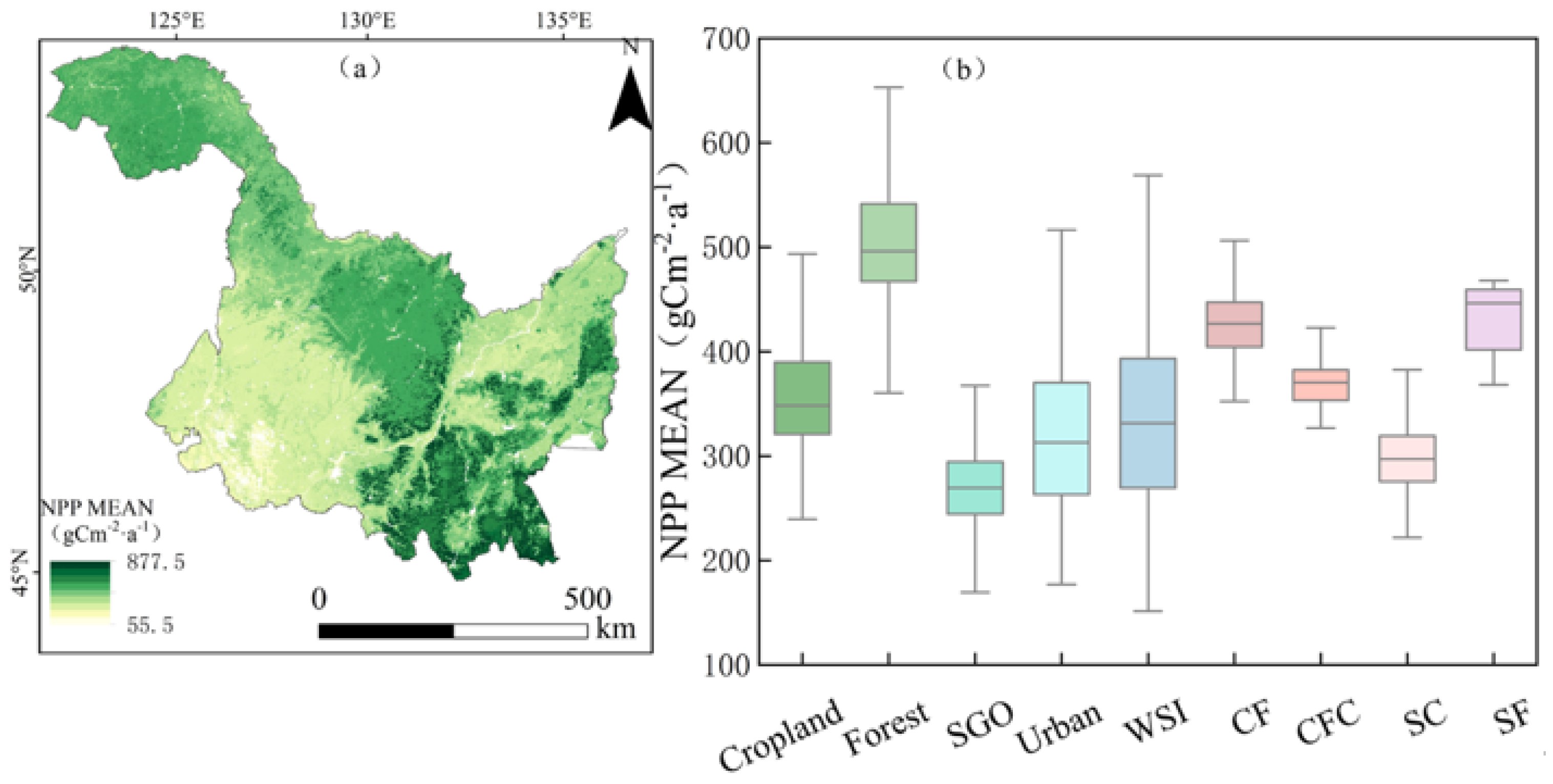
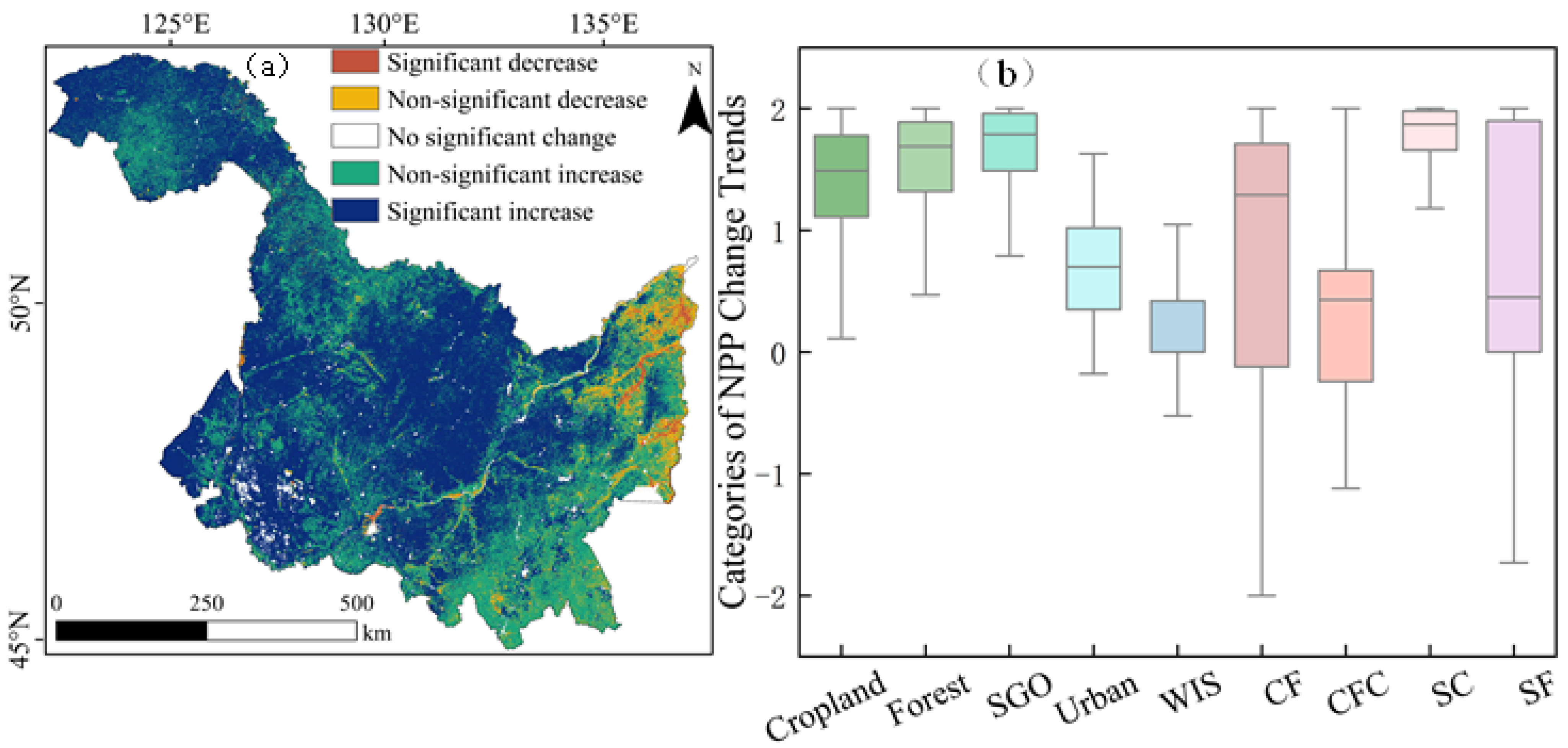
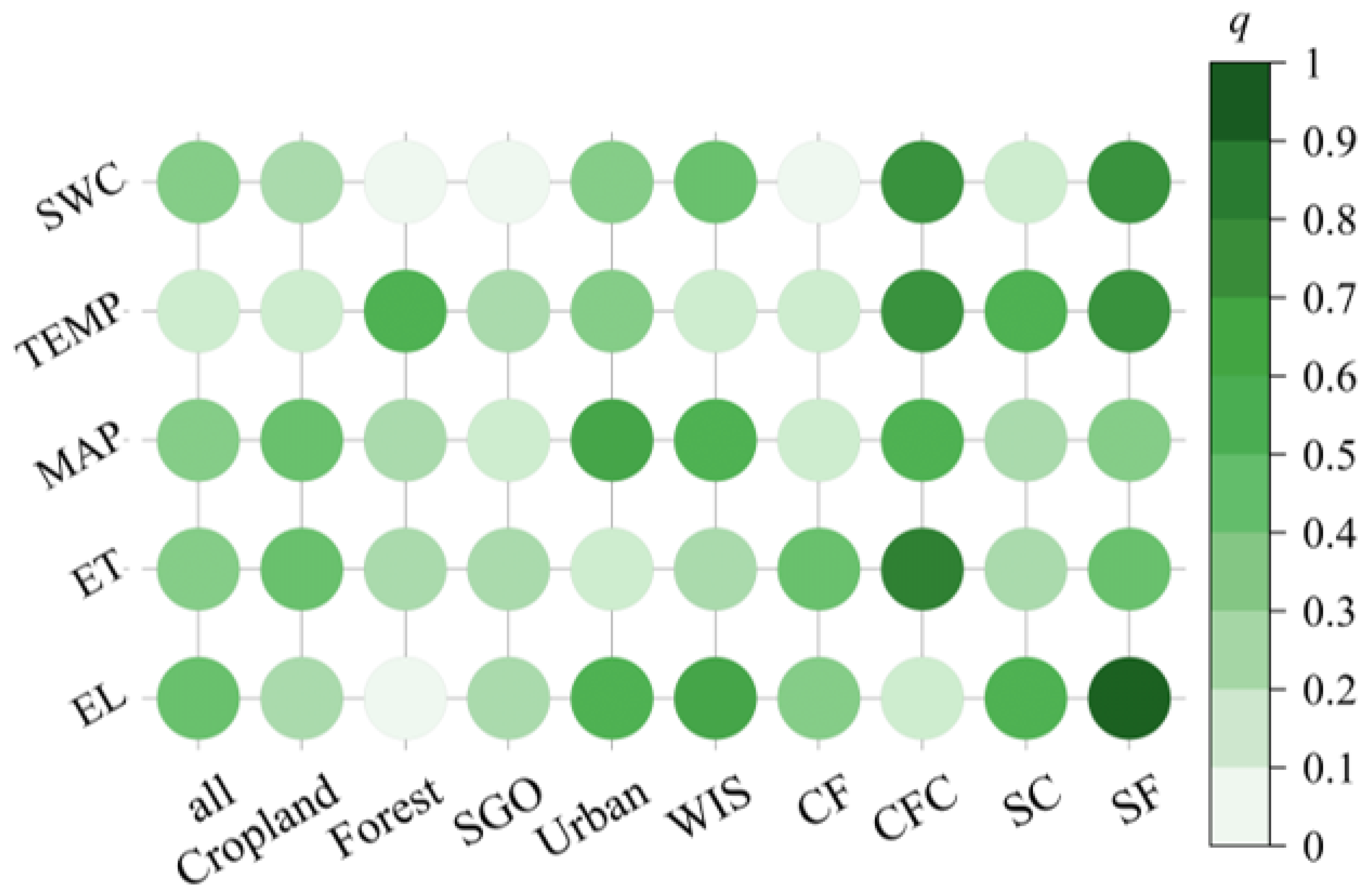
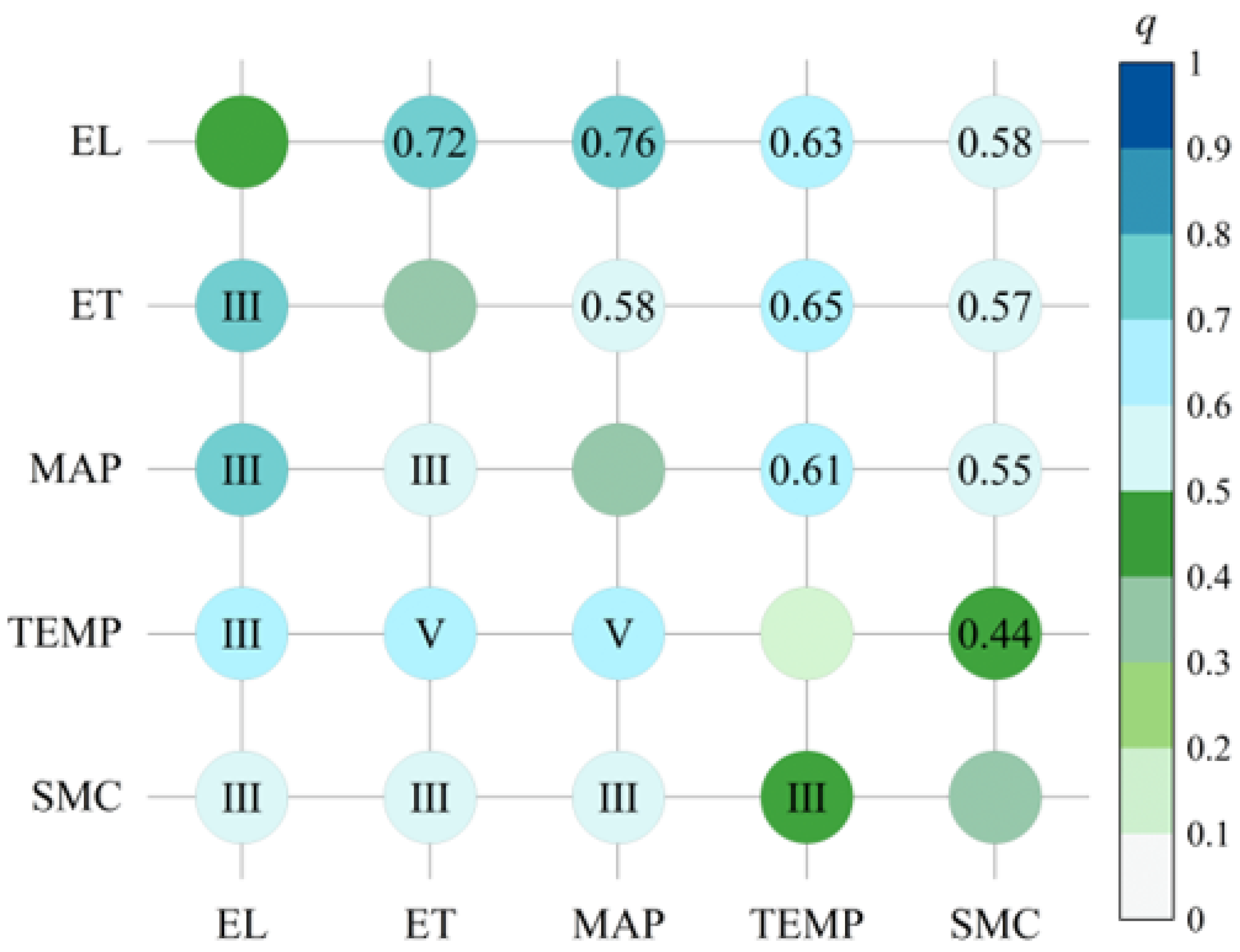
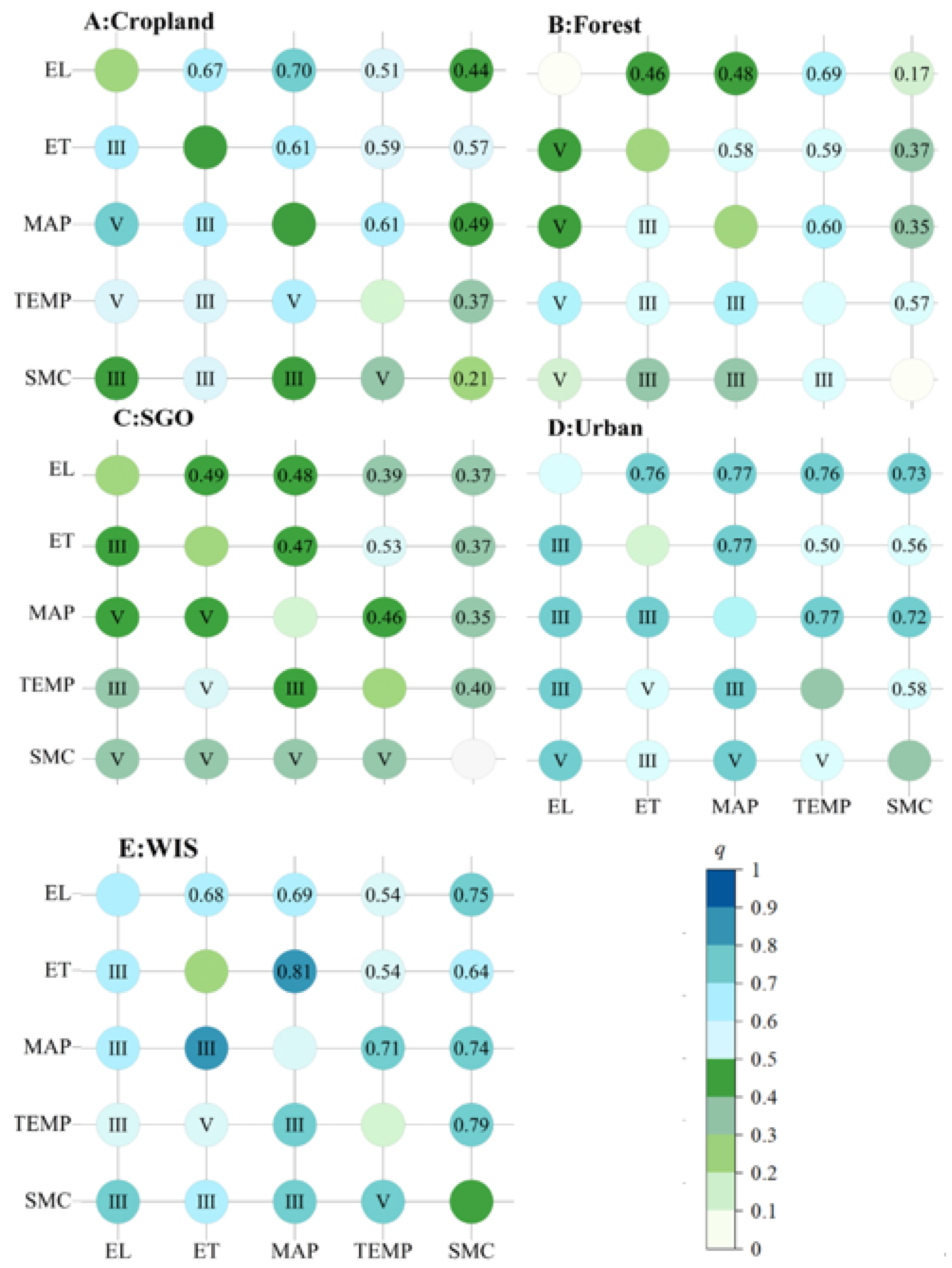

| Natural Factors | Data Source | Resolution | Unit |
|---|---|---|---|
| EL | Geospatial Information Authority of Japan (https://globalmaps.github.io/el.html, accessed on 20 August 2025) | 1 km | m |
| ET | MODIS/Terra Evapotranspiration Product (https://doi.org/10.5067/MODIS/MOD16A3GF.061) | 500 m | kg/m−2·a−1 |
| MAP | National Tibetan Plateau Data Center (https://doi.org/10.5281/zenodo.3185722) | 1 km | mm |
| TEMP | National Tibetan Plateau Data Center (https://doi.org/10.5281/zenodo.3185722) | 1 km | °C |
| SMC | National Tibetan Plateau Data Center (https://doi.org/10.11888/Terre.tpdc.272415) | 1 km | mm |
| Criterion for Discrimination | Type of Interaction | Number |
|---|---|---|
| q (X1 ∩ X2) < Min [q (X1), q (X2)] | Nonlinear Weakening | I |
| Min [q (X1), q (X2)] < q (X1 ∩ X2) < Max [q (X1), q (X2)] | Single-Factor Nonlinear Weakening | II |
| q (X1 ∩ X2) > Max [q (X1), q (X2)] | Two-Factor Enhancement | III |
| q (X1 ∩ X2) = q (X1) + q (X2) | Independent | IV |
| q (X1 ∩ X2) > q (X1) + q (X2) | Nonlinear Enhancement | V |
| Land Type | Cropland | Forest | SGO | Urban | WIS | SC | CF | SF | CFC |
|---|---|---|---|---|---|---|---|---|---|
| Area (km2) | 158,696 | 201,677 | 13,830 | 4305 | 2915 | 16,417 | 13,641 | 3786 | 3019 |
| Percentage (%) | 35.08 | 44.59 | 3.06 | 0.95 | 0.64 | 3.63 | 3.02 | 0.83 | 0.67 |
Disclaimer/Publisher’s Note: The statements, opinions and data contained in all publications are solely those of the individual author(s) and contributor(s) and not of MDPI and/or the editor(s). MDPI and/or the editor(s) disclaim responsibility for any injury to people or property resulting from any ideas, methods, instructions or products referred to in the content. |
© 2025 by the authors. Licensee MDPI, Basel, Switzerland. This article is an open access article distributed under the terms and conditions of the Creative Commons Attribution (CC BY) license (https://creativecommons.org/licenses/by/4.0/).
Share and Cite
Li, B.; Jiang, Q.; Zhao, Y.; Wang, Z.; Tao, M.; Qin, Y. The Impact of Natural Factors on Net Primary Productivity in Heilongjiang Province Under Different Land Use and Land Cover Changes. Agronomy 2025, 15, 2304. https://doi.org/10.3390/agronomy15102304
Li B, Jiang Q, Zhao Y, Wang Z, Tao M, Qin Y. The Impact of Natural Factors on Net Primary Productivity in Heilongjiang Province Under Different Land Use and Land Cover Changes. Agronomy. 2025; 15(10):2304. https://doi.org/10.3390/agronomy15102304
Chicago/Turabian StyleLi, Baohan, Qiuxiang Jiang, Youzhu Zhao, Zilong Wang, Meiyun Tao, and Yu Qin. 2025. "The Impact of Natural Factors on Net Primary Productivity in Heilongjiang Province Under Different Land Use and Land Cover Changes" Agronomy 15, no. 10: 2304. https://doi.org/10.3390/agronomy15102304
APA StyleLi, B., Jiang, Q., Zhao, Y., Wang, Z., Tao, M., & Qin, Y. (2025). The Impact of Natural Factors on Net Primary Productivity in Heilongjiang Province Under Different Land Use and Land Cover Changes. Agronomy, 15(10), 2304. https://doi.org/10.3390/agronomy15102304






